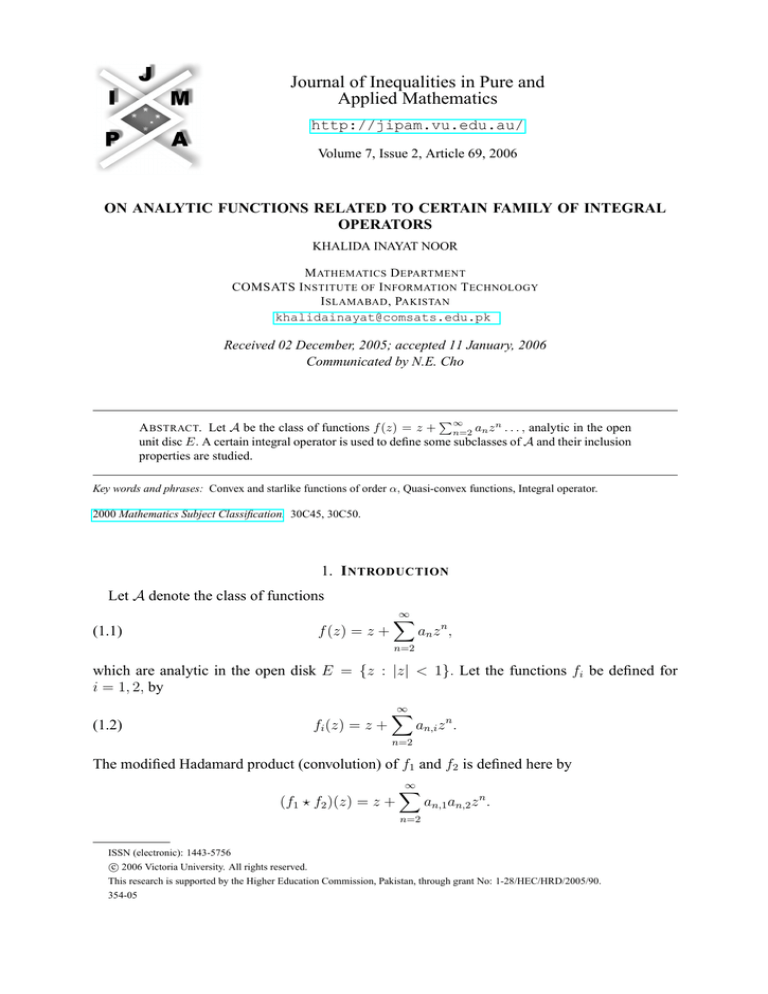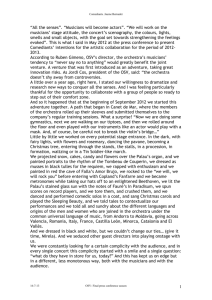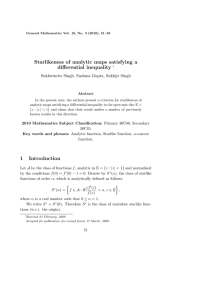
Journal of Inequalities in Pure and
Applied Mathematics
http://jipam.vu.edu.au/
Volume 7, Issue 2, Article 69, 2006
ON ANALYTIC FUNCTIONS RELATED TO CERTAIN FAMILY OF INTEGRAL
OPERATORS
KHALIDA INAYAT NOOR
M ATHEMATICS D EPARTMENT
COMSATS I NSTITUTE OF I NFORMATION T ECHNOLOGY
I SLAMABAD , PAKISTAN
khalidainayat@comsats.edu.pk
Received 02 December, 2005; accepted 11 January, 2006
Communicated by N.E. Cho
P∞
A BSTRACT. Let A be the class of functions f (z) = z + n=2 an z n . . . , analytic in the open
unit disc E. A certain integral operator is used to define some subclasses of A and their inclusion
properties are studied.
Key words and phrases: Convex and starlike functions of order α, Quasi-convex functions, Integral operator.
2000 Mathematics Subject Classification. 30C45, 30C50.
1. I NTRODUCTION
Let A denote the class of functions
(1.1)
f (z) = z +
∞
X
an z n ,
n=2
which are analytic in the open disk E = {z : |z| < 1}. Let the functions fi be defined for
i = 1, 2, by
(1.2)
fi (z) = z +
∞
X
an,i z n .
n=2
The modified Hadamard product (convolution) of f1 and f2 is defined here by
(f1 ? f2 )(z) = z +
∞
X
an,1 an,2 z n .
n=2
ISSN (electronic): 1443-5756
c 2006 Victoria University. All rights reserved.
This research is supported by the Higher Education Commission, Pakistan, through grant No: 1-28/HEC/HRD/2005/90.
354-05
2
K HALIDA I NAYAT N OOR
Let Pk (β) be the class of functions h(z) analytic in the unit disc E satisfying the properties
h(0) = 1 and
Z 2π h(z) − β Re
dθ ≤ kπ,
(1.3)
1−β 0
where z = reiθ , k ≥ 2 and 0 ≤ β < 1, see [4]. For β = 0, we obtain the class Pk defined
by Pinchuk [5]. The case k = 2, β = 0 gives us the class P of functions with positive real part,
and k = 2, P2 (β) = P (β) is the class of functions with positive real part greater than β.
Also we can write for h ∈ Pk (β)
Z
1 2π 1 + (1 − 2β)ze−it
(1.4)
h(z) =
dµ(t),
2 0
1 − ze−it
where µ(t) is a function with bounded variation on [0, 2π] such that
Z 2π
Z 2π
(1.5)
dµ(t) = 2 and
|dµ(t)| ≤ k.
0
0
From (1.4) and (1.5), we can write, for h ∈ Pk (β),
k 1
k 1
(1.6)
h(z) =
+
h1 (z) −
−
h2 (z), h1 , h2 ∈ P (β).
4 2
4 2
We have the following classes:
zf 0 (z)
∈ Pk (α), z ∈ E, 0 ≤ α < 1 .
Rk (α) = f : f ∈ A and
f (z)
We note that R2 (α) = S ? (α) is the class of starlike functions of order α.
(zf 0 (z))0
Vk (α) = f : f ∈ A and
∈ Pk (α), z ∈ E, 0 ≤ α < 1 .
f 0 (z)
Note that V2 (α) = C(α) is the class of convex functions of order α.
zf 0 (z)
Tk (β, α) = f : f ∈ A, g ∈ R2 (α) and
∈ Pk (β), z ∈ E,
g(z)
0 ≤ α, β < 1 .
We note that T2 (0, 0) is the class K of close-to-convex univalent functions.
(zf 0 (z))0
?
Tk (β, α) = f : f ∈ A, g ∈ V2 (α) and
∈ Pk (β), z ∈ E, 0 ≤ α, β < 1 .
g 0 (z)
In particular, the class T2? (β, α) = C ? (β, α) was considered by Noor [3] and for T2? (0, 0) = C ?
is the class of quasi-convex univalent functions which was first introduced and studied in [2].
It can be easily seen from the above definitions that
(1.7)
f (z) ∈ Vk (α)
⇐⇒
zf 0 (z) ∈ Rk (α)
f (z) ∈ Tk? (β, α)
⇐⇒
zf 0 (z) ∈ Tk (β, α).
and
(1.8)
We consider the following integral operator Lµλ : A −→ A, for λ > −1; µ > 0; f ∈ A,
µ−1
Z z
t
µ
λ+µ µ
λ−1
Lλ f (z) = Cλ
t
1−
f (t)dt
zλ 0
z
∞
Γ(λ + µ + 1) X Γ(λ + n)
(1.9)
=z+
an z n ,
Γ(λ + 1) n=2 Γ(λ + µ + n)
J. Inequal. Pure and Appl. Math., 7(2) Art. 69, 2006
http://jipam.vu.edu.au/
O N A NALYTIC F UNCTIONS R ELATED TO C ERTAIN FAMILY OF I NTEGRAL O PERATORS
3
where Γ denotes the Gamma function. From (1.9), we can obtain the well-known generalized
Bernadi operator as follows:
Z
µ + 1 z µ−1
Iµ f (z) =
t f (t)dt
zµ
0
∞
X
µ+1
=z+
an z n , µ > −1; f ∈ A.
µ+n
n=2
We now define the following subclasses of A by using the integral operator Lµλ .
Definition 1.1. Let f ∈ A. Then f ∈ Rk (λ, µ, α) if and only if
Lµλ f ∈ Rk (α),
Definition 1.2. Let f ∈ A. Then f ∈ Vk (λ, µ, α) if and only if
Lµλ f ∈ Vk (α), for z ∈ E.
Definition 1.3. Let f ∈ A. Then f ∈ Tk (λ, µ, β, α) if and only if
for z ∈ E.
Lµλ f ∈ Tk (β, α), for z ∈ E.
Definition 1.4. Let f ∈ A. Then f ∈ Tk? (λ, µ, β, α) if and only if
z ∈ E.
Lµλ f ∈ Tk? (β, α), for
We shall need the following result.
Lemma 1.1 ([1]). Let u = u1 + iu2 and v = v1 + iv2 and let Φ be a complex-valued function
satisfying the conditions:
(i) Φ(u, v) is continuous in a domain D ⊂ C2 ,
(ii) (1, 0) ∈ D and Φ(1, 0) > 0.
(iii) Re Φ(iu2 , v1 ) ≤ 0, whenever (iu2 , v1 ) ∈ D and v1 ≤ − 21 (1 + u22 ).
P
m
If h(z) = 1 + ∞
is a function analytic in E such that (h(z), zh0 (z)) ∈ D and
m=2 cm z
0
Re Φ(h(z), zh (z)) > 0 for z ∈ E, then Re h(z) > 0 in E.
2. M AIN R ESULTS
Theorem 2.1. Let f ∈ A, λ > −1, µ > 0 and λ + µ > 0. Then Rk (λ, µ, 0) ⊂ Rk (λ, µ + 1, α),
where
2
p
, with β = 2(λ + µ).
(2.1)
α=
(β + 1) + β 2 + 2β + 9
Proof. Let f ∈ Rk (λ, µ, 0) and let
0
zLµ+1
k 1
k 1
λ f (z)
= p(z) =
+
p1 (z) −
−
p2 (z),
4 2
4 2
Lµ+1
λ f (z)
where p(0) = 1 and p(z) is analytic in E. From (1.9), it can easily be seen that
0
µ
µ+1
(2.2)
z Lµ+1
λ f (z) = (λ + µ + 1)Lλ f (z) − (λ + µ)Lλ f (z).
Some computation and use of (2.2) yields
z (Lµλ f (z))0
zp0 (z)
= p(z) +
∈ Pk , z ∈ E.
Lµλ f (z)
p(z) + λ + µ
Let
∞
X
(λ + µ) + j j
Φλ,µ (z) =
z
λ
+
µ
+
1
j=1
λ+µ
z
1
z
=
+
.
λ+µ+1 1−z
λ + µ + 1 (1 − z)2
J. Inequal. Pure and Appl. Math., 7(2) Art. 69, 2006
http://jipam.vu.edu.au/
4
K HALIDA I NAYAT N OOR
Then
p(z) ? Φλ,µ (z)
zp0 (z)
= p(z) +
p(z) + λ + µ
k 1
k 1
+
[p1 (z) ? Φλ,µ (z)] −
−
[p2 (z) ? Φλ,µ (z)]
=
4 2
4 2
zp01 (z)
k 1
zp02 (z)
k 1
=
+
p1 (z) +
−
−
p2 (z) +
,
4 2
p1 (z) + λ + µ
4 2
p2 (z) + λ + µ
and this implies that
zp0i (z)
pi (z) +
∈ P, z ∈ E.
pi (z) + λ + µ
We want to show that pi (z) ∈ P (α), where α is given by (2.1) and this will show that p ∈ Pk (α)
for z ∈ E. Let
pi (z) = (1 − α)hi (z) + α, i = 1, 2.
Then
(1 − α)zh0i (z)
∈ P.
(1 − α)hi (z) + α +
(1 − α)hi (z) + α + λ + µ
We form the functional Ψ(u, v) by choosing u = hi (z), v = zh0i . Thus
Ψ(u, v) = (1 − α)u + α +
(1 − α)v
.
(1 − α)u + (α + λ + µ)
The first two conditions of Lemma 1.1 are clearly satisfied. We verify the condition (iii) as
follows.
(1 − α)(α + λ + µ)v1
Re Ψ(iu2 , v1 ) = α +
2.
(α + λ + µ)2 + (1 − α)2 u2
2
By putting v1 ≤ −
(1+u2 )
,
2
we obtain
Re Ψ(iu2 , v1 )
≤α−
1 (1 − α)(α + λ + µ)(1 + u22 )
2 (α + λ + µ)2 + (1 − α)2 u22
2
2α(α + λ + µ)2 + 2α(1 − α)2 u2 − (1 − α)(α + λ + µ) − (1 − α)(α + λ + µ)u22
=
2[(α + λ + µ)2 + (1 − α)2 u22 ]
A + Bu22
=
,
2C
where
A = 2α(α + λ + µ)2 − (1 − α)(α + λ + µ),
B = 2α(1 − α)2 − (1 − α)(α + λ + µ),
C = (α + λ + µ)2 + (1 − α)2 u22 > 0.
We note that Re Ψ(iu2 , v1 ) ≤ 0 if and only if, A ≤ 0 and B ≤ 0. From A ≤ 0, we obtain α as
given by (2.1) and B ≤ 0 gives us 0 ≤ α < 1, and this completes the proof.
Theorem 2.2. For λ > −1, µ > 0 and (λ + µ) > 0,
is given by (2.1).
J. Inequal. Pure and Appl. Math., 7(2) Art. 69, 2006
Vk (λ, µ, 0) ⊂ Vk (λ, µ + 1, α), where α
http://jipam.vu.edu.au/
O N A NALYTIC F UNCTIONS R ELATED TO C ERTAIN FAMILY OF I NTEGRAL O PERATORS
5
Proof. Let f ∈ Vk (λ, µ, 0). Then Lµλ f ∈ Vk (0) = Vk and, by (1.7) z(Lµλ )0 ∈ Rk (0) = Rk . This
implies
Lµλ (zf 0 ) ∈ Rk =⇒ zf 0 ∈ Rk (λ, µ, 0) ⊂ Rk (λ, µ + 1, α).
Consequently f ∈ Vk (λ, µ + 1, α), where α is given by (2.1).
Theorem 2.3. Let λ > −1, µ > 0 and (λ + µ) > 0. Then
Tk (λ, µ, β, 0) ⊂ Tk (λ, µ + 1, γ, α),
where α is given by (2.1) and γ ≤ β is defined in the proof.
Proof. Let f ∈ Tk (λ, µ, 0). Then there exists
for z ∈ E, 0 ≤ β < 1. Let
g ∈ R2 (λ, µ, 0) such that
n
0
z(Lµ
λf )
Lµ
g
λ
o
∈ Pk (β),
0
z(Lµ+1
λ f (z))
= (1 − γ)p(z) + γ
Lµ+1
λ g(z)
k 1
k 1
=
+
{(1 − γ)p1 (z) + γ} −
−
{(1 − γ)p2 (z) + γ},
4 2
4 2
where p(0) = 1, and p(z) is analytic in E.
Making use of (2.2) and Theorem 2.1 with k = 2, we have
z(Lµλ f (z))0
(1 − γ)zp0 (z)
(2.3)
− β = (1 − γ)p(z) + (γ − β) +
∈ Pk ,
Lµλ g(z)
(1 − α)q(z) + α + λ + µ
and q ∈ P, where
0
z Lµ+1
λ g(z)
(1 − α)q(z) + α =
, z ∈ E.
Lµ+1
λ g(z)
Using (1.6), we form the functional Φ(u, v) by taking u = u1 + iu2 = pi (z), v = v1 + iv2 = zp0i
in (2.3) as
(1 − γ)v
(2.4)
Φ(u, v) = (1 − γ)u + (γ − β) +
.
(1 − α)q(z) + α + λ + µ
It can be easily seen that the function Φ(u, v) defined by (2.4) satisfies the conditions (i) and (ii)
of Lemma 1.1. To verify the condition (iii), we proceed, with q(z) = q1 + iq2 , as follows:
(1 − γ)v1
Re [Φ(iu2 , v1 )] = (γ − β) + Re
(1 − α)(q1 + iq2 ) + α + λ + µ
(1 − γ)(1 − α)v1 q1 + (1 − γ)(α + λ + µ)v1
= (γ − β) +
[(1 − α)q1 + α + λ + µ]2 + (1 − α)2 q22
1 (1 − γ)(1 − α)(1 + u22 )q1 + (1 − γ)(α + λ + µ)(1 + u22 )
≤ (γ − β) −
2
[(1 − α)q1 + α + λ + µ]2 + (1 − α)2 q22
≤ 0, for γ ≤ β < 1.
Therefore, applying Lemma 1.1, pi ∈ P, i = 1, 2 and consequently p ∈ Pk and thus f ∈
Tk (λ, µ + 1, γ, α).
Using the same technique and relation (1.8) with Theorem 2.3, we have the following.
Theorem 2.4. For λ > −1, µ > 0, λ + µ > 0, Tk? (λ, µ, β, 0) ⊂ Tk? (λ, µ + 1, γ, α), where γ
and α are as given in Theorem 2.3.
Remark 2.5. For different choices of k, λ and µ, we obtain several interesting special cases of
the results proved in this paper.
J. Inequal. Pure and Appl. Math., 7(2) Art. 69, 2006
http://jipam.vu.edu.au/
6
K HALIDA I NAYAT N OOR
R EFERENCES
[1] S.S. MILLER, Differential inequalities and Carathéordary functions, Bull. Amer. Math. Soc., 81
(1975), 79–81.
[2] K. INAYAT NOOR, On close-to-convex and related functions, Ph.D Thesis, University of Wales,
U.K., 1972.
[3] K. INAYAT NOOR, On quasi-convex functions and related topics, Int. J. Math. Math. Sci., 10 (1987),
241–258.
[4] K.S. PADMANABHAN AND R. PARVATHAM, Properties of a class of functions with bounded
boundary rotation, Ann. Polon. Math., 31 (1975), 311–323.
[5] B. PINCHUK, Functions with bounded boundary rotation, Israel J. Math., 10 (1971), 7–16.
J. Inequal. Pure and Appl. Math., 7(2) Art. 69, 2006
http://jipam.vu.edu.au/











